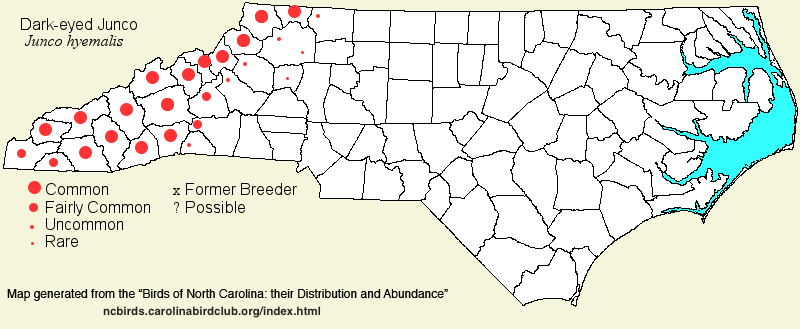 |  |
|
Dark-eyed Junco - Junco hyemalis PASSERELLIDAE Members: | Search Common: Search Scientific: |
|
|
|||||||
| General Comments | The Dark-eyed Junco has been a taxonomic "nightmare" for decades. Until a few decades ago, this species had been split into an Eastern species, the Slate-colored Junco, and several in the West -- Oregon Junco, Gray-headed Junco, and White-winged Junco. The combined species has a wide breeding range from Alaska to Newfoundland, south through the Appalachians, the Rockies, and the Sierra Nevadas. It winters across the entirety of the United States, except for much of Florida. In North Carolina, it is one of the most widespread and common of the breeding birds of the forested areas in the mountains, from middle elevations to the tops of the highest peaks. Downstate, a few may breed in some western Piedmont ranges, but it is essentially seen only in the cooler months; it also winters in the mountains. Breeding habitats are most any type of cool forest -- spruce-fir, mixed spruce-hardwood, hemlock (formerly) or White Pine stands, cove and northern hardwood forests, and also in wooded residential areas. It is not numerous in the drier forests dominated by oaks. In winter, they occurs in large numbers, in flocks, usually along the margins of various forests and thickets. Favored areas are along roadsides through pine or mixed forests, small openings in such forests, edges of thickets, wooded residential areas, and other grassy places not far from cover. There are numerous records of several Western subspecies in the state, but as some are uncertain as to subspecies, a complete tally of each subspecies is not possible. | ||||||
| Breeding Status | Breeder | ||||||
| NC BRC List | Definitive | ||||||
| State Status | |||||||
| U.S. Status | |||||||
| State Rank | S5B,S5N | ||||||
| Global Rank | G5 | ||||||
| Coastal Plain | Winter resident. Common to very common over the western and central portions; fairly common to common in the Tidewater portion; fairly common in the southeastern portion. Along the coast, mainly a fairly common fall migrant, but departs inland by early winter, and scarce in midwinter. Mainly early Oct to mid-Apr. One was quite late at Dare Bombing Range, 27 May 2001, as was another in southwestern Moore from 21-31 May 2021. Peak counts: | ||||||
| Piedmont | Winter resident, and a very sparse breeder in a few foothill ranges. Very common to abundant in winter over nearly all of the region. In summer, a few records from the Brushy Mountains, at least prior to 1970, but current status unknown. A few occur in summer in the Chimney Rock Park area, along the edge of the mountain region. Mainly mid-Oct to mid-Apr. Peak counts: | ||||||
| Mountains | Permanent resident (but not in summer at low elevations), with migratory movements. Common to very common in summer at middle to higher elevations, down to about 3,000 feet, sparingly even below 2,000 feet. In winter, common to abundant across the region, even at higher elevations. Peak counts: | ||||||
| Finding Tips |
None needed. **** | ||||||
| Attribution | LeGrand[2023-03-31], LeGrand[2021-09-04], LeGrand[2013-03-15] | ||||||
| NC Map Map depicts all counties with a report (transient or resident) for the species. | Click on county for list of all known species. |
| NC Breeding Season Map Map depicts assumed breeding season abundance for the species. |  |